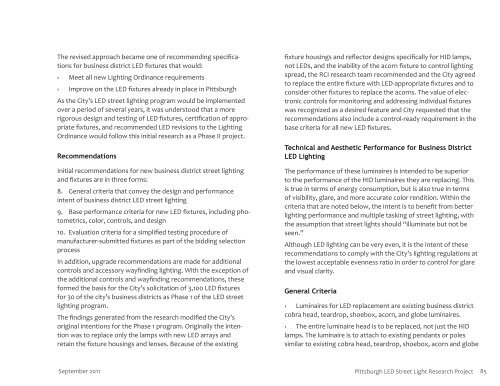LED Street Light Research Project
LED Street Light Research Project
LED Street Light Research Project
Create successful ePaper yourself
Turn your PDF publications into a flip-book with our unique Google optimized e-Paper software.
The revised approach became one of recommending specifications<br />
for business district <strong>LED</strong> fixtures that would:<br />
› Meet all new <strong>Light</strong>ing Ordinance requirements<br />
› Improve on the <strong>LED</strong> fixtures already in place in Pittsburgh<br />
As the City’s <strong>LED</strong> street lighting program would be implemented<br />
over a period of several years, it was understood that a more<br />
rigorous design and testing of <strong>LED</strong> fixtures, certification of appropriate<br />
fixtures, and recommended <strong>LED</strong> revisions to the <strong>Light</strong>ing<br />
Ordinance would follow this initial research as a Phase II project.<br />
Recommendations<br />
Initial recommendations for new business district street lighting<br />
and fixtures are in three forms:<br />
8. General criteria that convey the design and performance<br />
intent of business district <strong>LED</strong> street lighting<br />
9. Base performance criteria for new <strong>LED</strong> fixtures, including photometrics,<br />
color, controls, and design<br />
10. Evaluation criteria for a simplified testing procedure of<br />
manufacturer-submitted fixtures as part of the bidding selection<br />
process<br />
In addition, upgrade recommendations are made for additional<br />
controls and accessory wayfinding lighting. With the exception of<br />
the additional controls and wayfinding recommendations, these<br />
formed the basis for the City’s solicitation of 3,100 <strong>LED</strong> fixtures<br />
for 30 of the city’s business districts as Phase 1 of the <strong>LED</strong> street<br />
lighting program.<br />
The findings generated from the research modified the City’s<br />
original intentions for the Phase 1 program. Originally the intention<br />
was to replace only the lamps with new <strong>LED</strong> arrays and<br />
retain the fixture housings and lenses. Because of the existing<br />
September 2011<br />
fixture housings and reflector designs specifically for HID lamps,<br />
not <strong>LED</strong>s, and the inability of the acorn fixture to control lighting<br />
spread, the RCI research team recommended and the City agreed<br />
to replace the entire fixture with <strong>LED</strong>-appropriate fixtures and to<br />
consider other fixtures to replace the acorns. The value of electronic<br />
controls for monitoring and addressing individual fixtures<br />
was recognized as a desired feature and City requested that the<br />
recommendations also include a control-ready requirement in the<br />
base criteria for all new <strong>LED</strong> fixtures.<br />
Technical and Aesthetic Performance for Business District<br />
<strong>LED</strong> <strong>Light</strong>ing<br />
The performance of these luminaires is intended to be superior<br />
to the performance of the HID luminaires they are replacing. This<br />
is true in terms of energy consumption, but is also true in terms<br />
of visibility, glare, and more accurate color rendition. Within the<br />
criteria that are noted below, the intent is to benefit from better<br />
lighting performance and multiple tasking of street lighting, with<br />
the assumption that street lights should “illuminate but not be<br />
seen.”<br />
Although <strong>LED</strong> lighting can be very even, it is the intent of these<br />
recommendations to comply with the City’s lighting regulations at<br />
the lowest acceptable evenness ratio in order to control for glare<br />
and visual clarity.<br />
General Criteria<br />
› Luminaires for <strong>LED</strong> replacement are existing business district<br />
cobra head, teardrop, shoebox, acorn, and globe luminaires.<br />
› The entire luminaire head is to be replaced, not just the HID<br />
lamps. The luminaire is to attach to existing pendants or poles<br />
similar to existing cobra head, teardrop, shoebox, acorn and globe<br />
Pittsburgh <strong>LED</strong> <strong>Street</strong> <strong>Light</strong> <strong>Research</strong> <strong>Project</strong> 85


